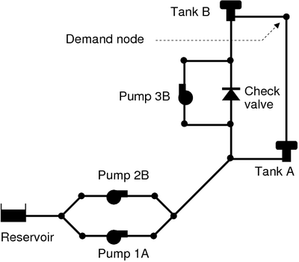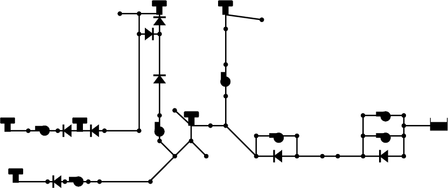 Water Distribution Network Instances of the Pump
Scheduling Problem
Water Distribution Network Instances of the Pump
Scheduling Problem
![]() NOTE: If you know about other
instances publicly available,
NOTE: If you know about other
instances publicly available,
please send them to me.
- Van Zyl test instance [ EPANET input file ]
-
Proposed by van Zyl et al. (2004).

- Richmond Network 95% [ EPANET input file ]
-
Richmond Standard Water Supply System 95% full tanks. This is a variant of Richmond's network with all tanks at a 95% initial level proposed by van Zyl et al. (2004) and later used by López-Ibáñez, et al. (2011).
The original Richmond network file is available from the Centre for Water Systems (CWS) of the University of Exeter. Note the CWS file might have changed over time and not exactly correspond to the version used in the works published in the literature.

Figure: Simplified schematic representation of the Richmond network. The networks in the INP files are not simplified.Sample solutions: These solutions correspond to row
20 ib 0.85 0.7 90.3 1.6 88.3 93.7 12 2.0 9 15
in Table B.4 of my PhD. See Appendix C for how to interpret the output. WARNING: Please, do not contact me unless you really understand the format and how to interpret it. Make sure you evaluate solutions using the EPANET Toolkit, since the graphical interface of EPANET cannot correctly evaluate time-based triggers.
- Richmond Network 95% Scenario #1 High Demand [ EPANET input file ]
-
Richmond Standard Water Supply System 95% full tanks with high demand (Scenario #1).
This is a variant of Richmond's network with all tanks at a 95% initial level and all base demands (Demand) in section DEMANDS increased by 10%. Proposed by López-Ibáñez, et al. (2011). - Richmond Network 95% Scenario #2 Low Demand [ EPANET input file ]
-
Richmond Standard Water Supply System 95% full tanks with low demand (Scenario #2).
This is a variant of Richmond's network with all tanks at a 95% initial level and all base demands (Demand) in section DEMANDS decreased by 10%. Proposed by López-Ibáñez, et al. (2011). - Richmond Network 95% Scenario #3 Random Demand [ EPANET input file ]
-
This is a variant of Richmond standard water supply network with all tanks at a 95% initial level and demand patterns randomly shuffled. Proposed by López-Ibáñez, et al. (2011).
Relevant Publications
-
Manuel
López-Ibáñez, T. Devi Prasad, and Ben Paechter.
Representations and
Evolutionary Operators for the Scheduling of Pump Operations in Water
Distribution Networks. Evolutionary Computation,
19(3):429–467, 2011.
- Van Zyl, J.E., Savic, D.A., Walters, G.A.
(2004). Operational Optimization of Water Distribution Systems Using a
Hybrid Genetic Algorithm. Journal of Water Resources Planning and
Management, ASCE, 130 (3), 160-170.
-
Manuel
López-Ibáñez, T. Devi Prasad, and Ben Paechter.
Ant
Colony Optimisation for the Optimal Control of Pumps in Water Distribution
Networks. Journal of Water Resources Planning and Management,
ASCE, 134(4):337–346, 2008.
-
Manuel
López-Ibáñez. Operational Optimisation of
Water Distribution Networks. PhD thesis, School of
Engineering and the Built Environment, Edinburgh Napier University, UK,
2009.
